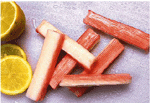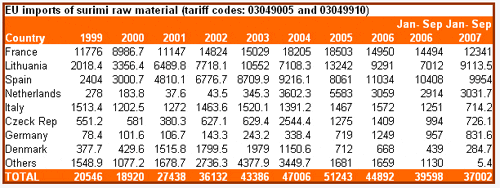Introduction
In the EU, the quality of surimi products is increasing, a gradual shift occurring from low quality frozen products to high quality chilled items. The main EU markets for surimi raw material for processing are France, Lithuania and Spain. At the same time, the main markets for surimi products for final consumption are Spain, France, Italy and the United Kingdom. Surimi products are available in countless forms: imitation crabmeat sticks, lobster tail imitations, lobster claw and crab claw meat, fish ham and sausages, fish cakes, breaded, mixed with cheese, with tuna, salmon, etc. Overall, in 2006, the largest consumer of surimi products in the EU was reported to be France with 52 200 tonnes, followed by Spain with 40 000 tonnes and Italy with 11 000 tonnes.
The market for surimi raw material
 |
French imports of surimi raw material increased from 11 800 tonnes in 1999 to 14 950 tonnes in 2006, peaking at 18 500 tonnes in 2005. In January-September 2007, French surimi raw material imports were 15 percent lower than in the same period of 2006. There are currently six companies processing surimi products from domestic and imported raw material, the latter purchased mainly from the USA and Chile. In 2006, surimi products amounted to 8 percent of the total output of the French seafood processing industry. In France, surimi products are generally traded in chilled form, the most popular being imitation crabmeat sticks. However, surimi products enjoying a higher degree of value addition are also popular, including sticks or portions with melted cheese and spices, or rolls filled with salmon, tuna or tzatziki. Clearly, the increased availability of new recipes is part of a strategy to keep national producers competitive against the influx of lower priced products from Asia.
Lithuania is the second most important market for surimi raw material in Europe. Lithuanian imports increased from 2 000 tonnes in 1999 to 9 300 tonnes in 2006, peaking at 13 200 tonnes in 2005. In January-September 2007, Lithuanian surimi imports reached 9 100 tonnes, a 30 percent increase from the same period of the previous year. Lithuania imports raw material mainly from the United States, France and Chile. The Viciunai Group, a local food processing company, has five plants (three of them in Lithuania, one in Estonia and one in the Russian Federation) processing surimi raw material into chilled or frozen products.
Spanish surimi raw material imports increased from 2 400 tonnes in 1999 to 11 000 tonnes in 2006. In January-September 2007, imports of raw material declined slightly (-4 percent) from the same period in 2006. Spanish companies are on the leading edge of innovation through their products based on traditional Spanish seafood dishes, the original being nowadays too expensive due to the scarcity of the raw material used. These products include imitation Cantabrian elvers (“gulas”) and imitation anchovies (“chovas”). At the same time, facing the decline of Alaska pollack stocks, a Spanish company has developed and patented a method to process surimi from giant squid (Dosidicus gigas).

The market for surimi products
Spain is the main importer of surimi products in the EU. These products are mostly of Asian origin, even if imports from Lithuania are increasing. Spanish imports declined from 1999 to 2002, but then they stabilized around 16 600 tonnes/year between 2002 and 2006. In January-September 2007, Spanish imports appeared to be steady in comparison with the same period in 2006.
Despite the presence of a significant processing industry, French imports of surimi products (mostly from Asia) increased from 5 100 tonnes in 1999 to 12 300 tonnes in 2006, equivalent to a yearly growth of 13 percent/year. In January-September 2007, imports of surimi products reached 9 600 tonnes, approximately the same figure as January-September 2006.
Italian surimi imports increased from 7 000 tonnes in 1999 to 10 600 tonnes in 2006. In January-September 2007, Italian imports reached 7 300 tonnes, which is a level comparable to that of January-September 2006. Surimi products consumed in Italy come from Lithuania and Asia. In Italy, surimi is consumed in the form of imitation crabmeat sticks, even if the number of supermarkets displaying surimi prawn/lobster tails is growing.

Outlook
In an otherwise mature seafood market such as the EU, surimi has still potential for expansion. Product development and alternative raw material sourcing are essential to keep the expansion going. In fact, the decline of Alaska pollock stocks has prompted producers to look for alternative sourcing; at the same time, international competition requires producers to diversify their product range. As long as surimi is ceasing to be considered as just a cheap substitute for the real thing in seafood, the protection of European production may require the introduction of special branding including certification of quality as well as environmental branding, such as the MSC label which has been recently awarded to Viciunai.
December 2007

